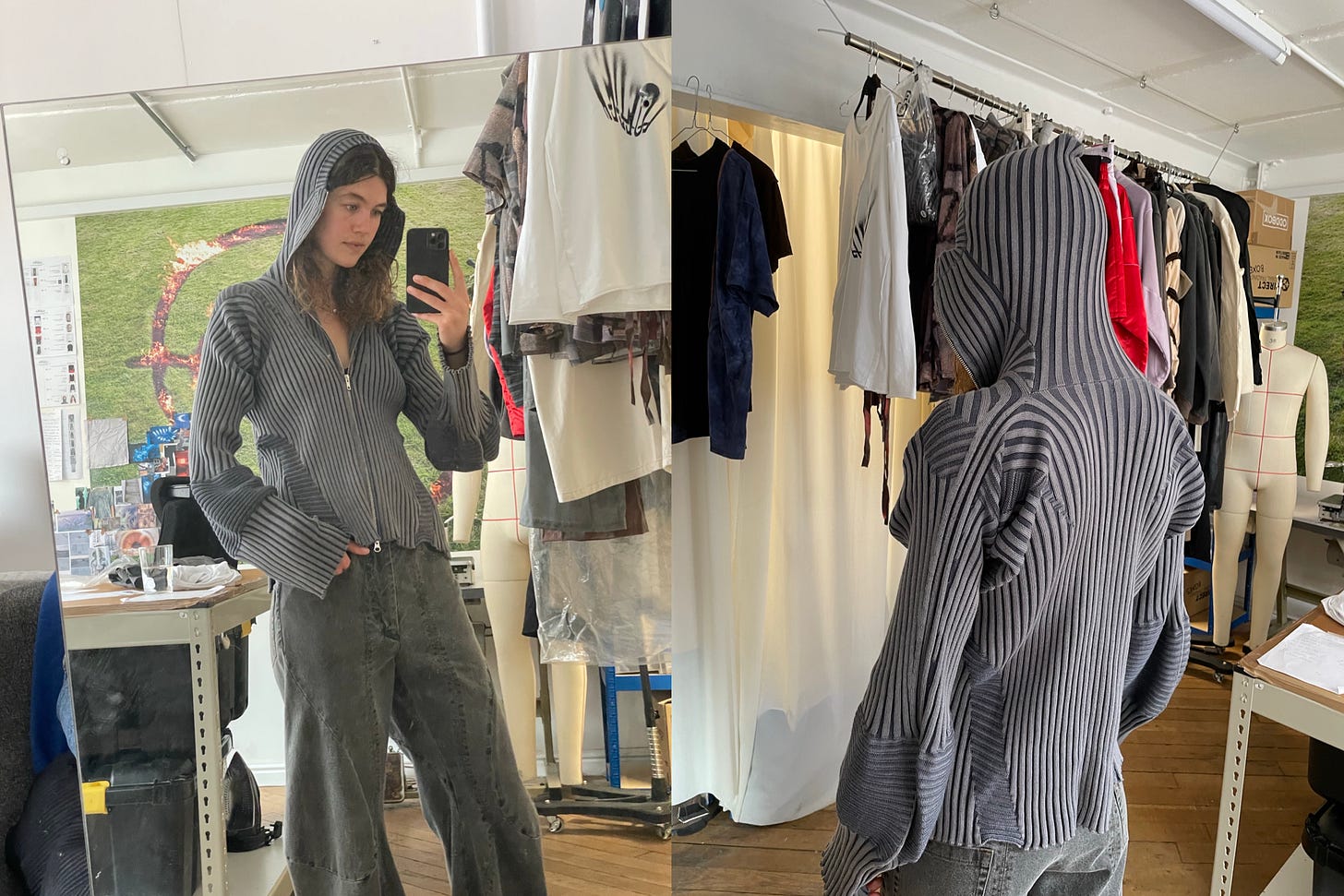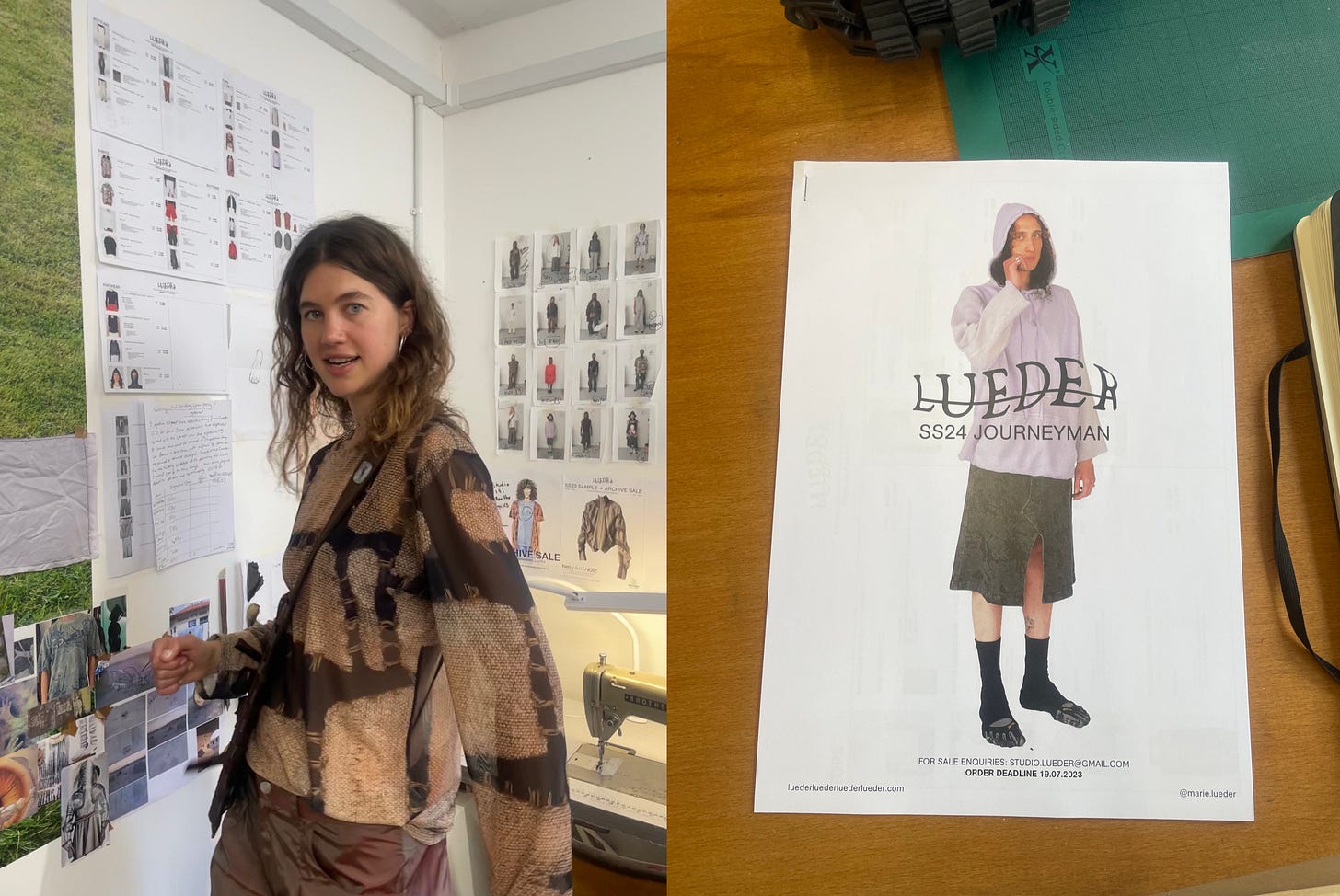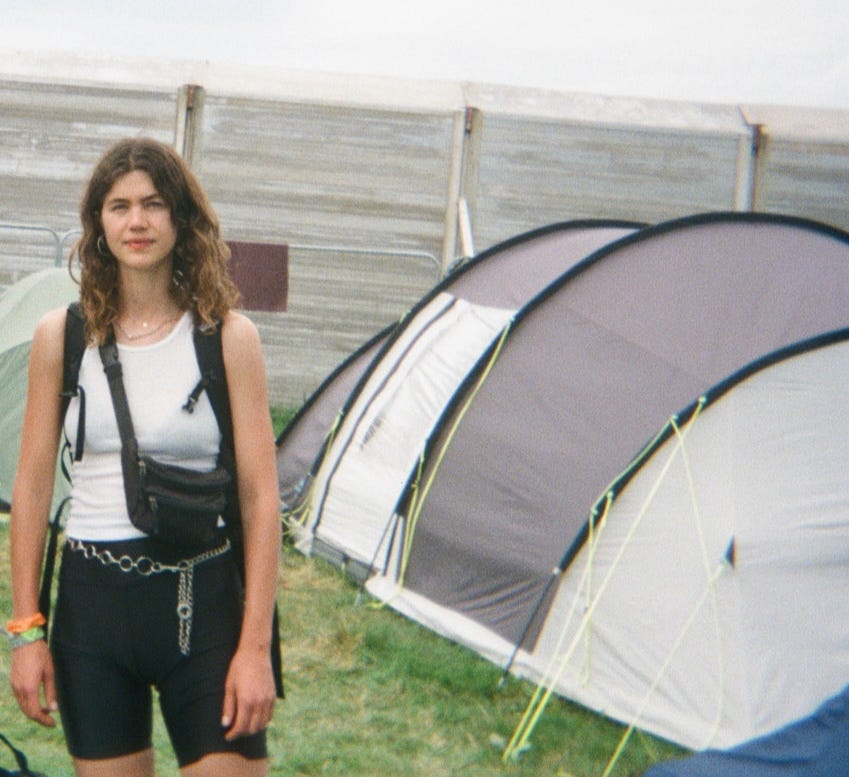A Thread about Marie Lueder
Visiting the designer at her studio and trying on her clothes
Yesterday I paid a visit to one of my favourite designers, Marie Lueder. Working in fashion, I’ve found that the whirring treadmill of the industry and its massive environmental impact means I rarely shop new, preferring secondhand pieces. Still, sometimes a brand is simply too good to ignore, ticking all the boxes and then some. Enter LUEDER. Stunning product, fascinating construction, a sustainable ethos and a really kind and genuine person behind it all. Here I chat to Marie about her work and have some fun playing dress up in her new collection.
Don’t forget to subscribe for more Threads of Conversation. You can also catch up on the podcast on Apple Podcasts or Spotify, and follow on Instagram and TikTok.
Talk me through starting your brand.
I was at the Royal College of Art for two years, and before that I studied tailoring in Hamburg for three years. In that very German way, I thought, OK, I have to learn it in the best way. So I went and trained to become a tailor - three years just making suits. Once you can make a suit you can basically make anything. Then I thought, okay, now that my hands are trained, I can concentrate on my brain.
What was it about fashion that appealed?
I like that it’s so collaborative. It’s not all about me; it’s meaningful to people and they can be transported by wearing the product.
Did your family support your ambitions in fashion?
My parents work in the healthcare sector. I think originally my mom didn’t respect fashion so much, but she loved art, so she always dragged me to art school graduate shows when I was 15 or 16. She’d ask everyone to explain their practice - as a teenager I was so embarrassed!
I feel like your work is very conceptual, but that doesn't detract from its wearability. That's what I love about it. It’s really steeped in ideas.
I think my method comes from these summer camps I used to go to between the ages of six and 12. They were organised by history students at the university in Hamburg. They had this very experimental professor who thought that if we tried living in the past, then we would better understand what actually happened. So it was like medieval LARP [live action role play]! Every summer, we would get a brief about five weeks before it started, and then my mom and I would research the clothes from that time - let’s say the year 1200 or 1500, or much earlier. Then we would make the clothes, and I would live there for a week. It was like a pagan tribe - picking and foraging, making fire with stones and stuff. We’d have a foundry to make our own money. We’d collect fruits and berries and learn how to mend clothes, how to make specific stitches, ways of treating leather. There was a bathhouse where we’d learn how to make cosmetic products like oils by collecting flowers. We’d have to live in the same way as the people from the chosen era, and suffer and strive in the same way.

I like this idea of developing a character, and I still do it in the same way. In building the character, we think about things like, how do people commute? What do they wear? How do they eat? What furniture do they buy? How do they live in this furniture? Do they go on holiday? It’s like market research, but also about care.
In my work I try to make the wearer feel supported and special - that can be in tiny details like the way the seams touch the body. I want it to look simple and not too draped, but actually there’s a lot of engineering which goes into things you can only feel when you wear the garments.
Can you tell me where your spiral motif comes from?
When I first moved to London, I lived in a warehouse. I was working very collaboratively and I was looking for a symbol for that. I was also working on a project for adidas where I was researching insects and flowers and shapes in nature. If you look at a plant, at the leaves on the twig from above, it’s actually a spiral shape. The leaves are arranged around the twig so that they don’t take each other’s sunlight. The spiral shape means you can be in the closest proximity to one other, but also be there by yourself. I wanted to represent the individual, but also being close to each other.
Our galaxy also looks like a spiral. There are so many spirals, actually. In Paris, the arrondissements are a spiral shape. When hot and cold air mix, it creates a spiral. And also the connection between heaven and earth in mediaeval times was represented by a coil-shaped snake. It’s a symbol for representing past, present and future. I thought, okay, that’s a good shape for me to represent the individual and the community. And I like how by using spiral shapes in my construction, the seams are touching the body and hugging the body.

Can you talk a bit about the construction of the knitted sweater that I tried on (above)?
We tried to implement this idea of mediaeval armour and protection. I wanted to put it into a very modern knit, something very easy to wear. And I thought, okay, maybe we can make a very engineered piece, but in soft, slouchy material. We also used this idea of the party tops you make as a kid, where you get a pair of tights and cut a hole in the crotch, and then put them over your head and wear them like a bolero sleeve-thing. We used that pattern to generate a lot of volume around the shoulder, so it looks very sculptural. Then when you wear the hood up, it looks a bit like a mediaeval helmet, and it has this little pointy dwarf nipple hood, which is fun! And if you fully zip it up then it’s like a balaclava, for when you want to be invisible.
Can you tell us a bit about the sustainability aspect of your brand?
Being trained as a tailor, you learn to adore fabrics, even the threads. You try not to ever waste anything. So that’s where I come from. I started with upcycling and found it had a very high fashion aspect. It’s like a couture process - you have to source the materials, it takes a long time to make, and each piece is one-off. You don't want to let them go - they’re kind of like your babies!

It takes time to develop your fabrics or find your favourite mills - things that are aesthetically pleasing but also champion sustainability. Right now I’m really happy with my cohort of fabric mills. One fabric we worked with for this collection is indigo-dyed. Indigo is a plant, and they have a huge field of it right next to the factory. All the nylons are made from recycled plastic bottles. We also use really good organic cotton, and waterless sublimation printing processes. The Journeyman bomber jacket is made from reused parachute nylon.

Then there’s a super cool new seacell knit we made in collaboration with Rosie Broadhead’s SKIN SERIES. She develops her own material which is an algae encapsulated knit, which is really good for the skin. So if you have eczema or sunburn or any kind of skin condition, it has healing properties.
Can you tell me a bit more about the new SS24 collection, ‘Journeyman’?
This season is more about these people in a community who are sharing knowledge together. We developed these different characters - there was a forager, someone who was a builder, someone taking care of different currencies.
We called it ‘Journeyman’ so it’s this idea of the hero’s journey. We developed all these characters as if they live in a dystopian future, inspired by the 1995 film Waterworld (it’s basically Mad Max on water.)
There are ideas of camouflage, but for an urban space - like rust prints, reflective surfaces in the nylons. Then we have elements of fierce power suits, but for us it was more like a boxing outfit. Boxing shorts and a very bright red jacket. Instead of using leather, we wanted to use something which looked similar, so we designed these fish skin prints on the cuban shirts and mesh pieces.
Each character also had a talisman. We wrote a prompt about how they live and who they are. This was then given to artist Thomas Grogan, who used AI to develop the shape. We then used these ornaments on parts of the collection.
It’s hard being a small brand, what are some of the sort of key lessons that you’ve learned?
I think the most difficult thing to manage is trust. My advice would be to try not to do everything, and try to find friends who can help you. I have one friend who used to have a brand and he’s really good at sales. So I can just send him things and say, oh, what do you think? Is that a good price? Or not? What should I say to this?
So yeah, stick to people you really admire. It's hard sometimes - there was a time last year when I was so overwhelmed and I felt like I needed a lot of advice. But somehow I became more insecure from that, because I felt like I couldn’t trust myself and my own instincts. You have to trust your gut instinct. Most of the time, it’s right.
‘Journeyman’ will be available to shop from early 2024. You can pre-order by emailing assistant.lueder@gmail.com, or shop LUEDER’s current collection at Browns, Farfetch, Slam Jam, Radd Lounge, Sealam Archive and Boutique Effe.
Threads of the week
No style experiments this week, just a simple outfit for rolling around in the dirt at Glastonbury and watching HAAi’s set. (Listen to her episode of the Threads of Conversation podcast here.)
Loose Threads
Santangelo’s waist chains are the apotheosis of hot girl summer.
Hua Hsu’s book is also on my birthday wishlist (shoutout Cancer szn.)
Start your own Thread
Add your thoughts in the comments, and let me know which Threads of Conversation you want to hear about next!







